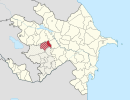
Incendiary weapons, incendiary devices, incendiary munitions, or incendiary bombs are weapons designed to start fires or destroy sensitive equipment using fire, that use materials such as napalm, thermite, magnesium powder, chlorine trifluoride, or white phosphorus. Though colloquially often known as bombs, they are not explosives but in fact are designed to slow the process of chemical reactions and use ignition rather than detonation to start and or maintain the reaction. Napalm for example, is petroleum especially thickened with certain chemicals into a 'gel' to slow, but not stop, combustion, releasing energy over a longer time than an explosive device. In the case of napalm, the gel adheres to surfaces and resists suppression.

The Khojaly Massacre, also known as the Khojaly genocide, was the killing of 613 ethnic Azerbaijani civilians from the town of Khojaly on 26 February 1992 by Armenian forces..

Karki or Tigranashen is a village that is de jure an exclave of the Nakhchivan Autonomous Republic of Azerbaijan. The village is near the border with Armenia, located on the bank of the Arpachay River near the Yerevan-Jermuk highway, which is 15 kilometres (9.3 mi) away from the district center. The area of the village itself is 950 hectares. Karki is de jure within the administrative territory of the Sadarak Rayon of Nakhchivan. It was occupied on January 19, 1990, by Armenian forces.
Fallujah, The Hidden Massacre is a documentary film by Sigfrido Ranucci and Maurizio Torrealta which first aired on Italy's RAI state television network on November 8, 2005. The film documents the use of weapons that the documentary asserts are chemical weapons, particularly the use of incendiary bombs, and alleges indiscriminate use of violence against civilians and children by military forces of the United States of America in the city of Fallujah in Iraq during the Fallujah Offensive of November 2004.

The Nagorno-Karabakh War was an ethnic and territorial conflict that took place in the late 1980s to May 1994, in the enclave of Nagorno-Karabakh in southwestern Azerbaijan, between the majority ethnic Armenians of Nagorno-Karabakh backed by the Republic of Armenia, and the Republic of Azerbaijan. As the war progressed, Armenia and Azerbaijan, both former Soviet Republics, entangled themselves in a protracted, undeclared war in the mountainous heights of Karabakh as Azerbaijan attempted to curb the secessionist movement in Nagorno-Karabakh. The enclave's parliament had voted in favor of uniting itself with Armenia and a referendum, boycotted by the Azerbaijani population of Nagorno-Karabakh, was held, whereby most of the voters voted in favor of independence. The demand to unify with Armenia began in a relatively peaceful manner in 1988; in the following months, as the Soviet Union disintegrated, it gradually grew into an increasingly violent conflict between Armenians and Azerbaijanis, resulting in claims of ethnic cleansing by both sides.

The Artsakh Republic Defense Army is the formal defense force of the largely unrecognized Republic of Artsakh (Nagorno-Karabakh). Established in 1992, it united previously disorganized self-defense units which were formed in the early 1990s with the avowed goal of protecting the ethnic Armenian population of Artsakh from the attacks by the Soviet and Azerbaijani armed forces. The Nagorno-Karabakh Defense Army is currently composed of around 20,000 well-trained and equipped officers and soldiers and maintains a "constant state of readiness, undergoing more serious combat training and operational exercises than any other former Soviet army."

The Nagorno-Karabakh conflict is a territorial and ethnic conflict between Armenia and Azerbaijan over the disputed region of Nagorno-Karabakh and seven surrounding districts, which are de facto controlled by the self-declared Republic of Artsakh, but are internationally recognized as de jure part of Azerbaijan. The conflict has its origins in the early 20th century. Under the Soviet Union, Joseph Stalin decided to make the Nagorno-Karabakh region, historically Armenian and with a majority-Armenian population, an autonomous oblast in Soviet Azerbaijan. The present conflict began in 1988, when the Karabakh Armenians demanded that Karabakh be transferred from Soviet Azerbaijan to Soviet Armenia. The conflict escalated into a full-scale war in the early 1990s.
The 1993 Summer Offensives of the Nagorno-Karabakh War saw the capture of several Azerbaijani regions by Armenian military units in a series of battles from June to August 1993.

The Armenian Air Force is the air arm formed by independent Armenia in 1992 in the wake of the dissolution of the Soviet Union. It is organized and equipped principally to provide Armenian ground forces with tactical air support in the form of ground attack and airlift in mountainous terrain. It provided effective support during the battles with Azerbaijan in the Nagorno-Karabakh region from 1992–1994. It currently lacks air superiority fighters, but air defense is provided by MiG-29s of the Russian Air Force under a military cooperation treaty. Since 2003, the Armenian government has been funding a modernization and enlargement of the air fleet.

There are no diplomatic relations between Armenia and Azerbaijan, largely due to the ongoing Nagorno-Karabakh conflict. The neighboring nations had formal governmental relations between 1918 and 1921, during their brief independence from the collapsed Russian Empire, as the First Republic of Armenia and the Democratic Republic of Azerbaijan; these relations existed from the period after the Russian Revolution until they were occupied and annexed by the Soviet Union. Due to the two wars waged by the countries in the past century—one from 1918 to 1921 and another from 1988 to 1994—the two have had strained relations.
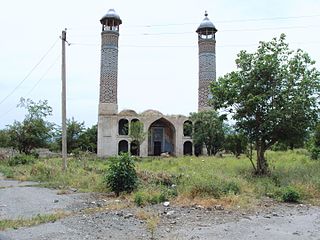
Ağdam is a ghost town in the southwest part of Azerbaijan and the formal capital of its Agdam District, today controlled by the de facto Republic of Artsakh, but de jure internationally recognized territory of the Republic of Azerbaijan. 'Aghdam' means small fortress in the ancient Turkic language. In the distant past, Turkic-speaking tribes who lived in this area used to build small fortresses to defend themselves. This historical fact emphasizes the Azerbaijani ethnic origin of the territory. Founded in the early 19th century, it grew considerably during the Soviet period and had 28,000 inhabitants by 1989. Armenian forces captured Agdam in July 1993 during the Nagorno-Karabakh War. The heavy fighting forced the entire population to flee eastwards. Upon seizing the city, Nagorno-Karabakh Republic (NKR) forces destroyed much of the town to discourage Azerbaijanis from returning. More damage occurred in the following decades when locals looted the abandoned town for building materials. It is currently almost entirely ruined and uninhabited. According to the United Nations Security Council's resolution #853 that 'Demands the immediate cessation of all hostilities, calls on withdrawal of Armenian troops from Agdam and other recently occupied areas of the Azerbaijani Republic and reaffirms UN Resolution 822'.

Voskepar is a village in the northeastern Tavush Province of Armenia, 163 kilometres (101 mi) north of Yerevan. It neighbors Yuxarı Əskipara village, an Armenian-controlled Azerbaijani exclave, as well as the other Azeri exclave of Aşağı Əskipara village.

Aşağı Əskipara is an abandoned village in the Qazakh Rayon of Azerbaijan. It is located along the border in territory occupied by Armenia since the Nagorno-Karabakh War. Nearby Voskepar is located in Armenia proper and Yuxarı Əskipara is in what is officially an exclave of Azerbaijan within Armenia, but which territory is controlled by Armenia.

The 1990 Tbilisi–Agdam bus bombing, also known as 1990 Khanlar bus bombing occurred on August 10, 1990, in the vicinity of Khanlar when an explosive device blew up in a bus 12.5 km away from Ganja, Azerbaijan's second largest city.
During the Nagorno-Karabakh War, Stepanakert, the largest city in Nagorno-Karabakh, was sieged by Azerbaijani forces. From late 1991 to May 1992 the city and its Armenian population was a target of a months-long campaign of intentional bombardment by Azerbaijan. The bombardment of Stepanakert and adjacent Armenian towns and villages, which took place under the conditions of total blockade by Azerbaijan, caused widespread destruction and many civilian deaths.
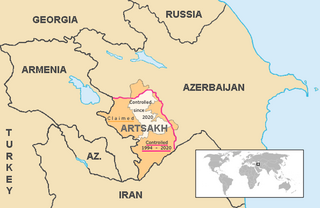
The 2012 border clashes between the armed forces of Armenia and Azerbaijan took place in early June. The clashes resulted in casualties on both sides.

The Four-Day War or April War, began along the Nagorno-Karabakh line of contact on 1 April 2016 with the Artsakh Defense Army, backed by the Armenian Armed Forces, on one side and the Azerbaijani Armed Forces on the other. The clashes occurred in a region that is disputed between the de facto Republic of Artsakh and Azerbaijan. The region includes Nagorno-Karabakh and surrounding areas. Azerbaijani forces sought to regain territory formerly within the Soviet-era Nagorno-Karabakh Autonomous Oblast. The clashes have been defined as "the worst" since the 1994 ceasefire. The battles resulted in the conquest of the Azerbaijani Armed Forces, the hills around the Talish village of Terter and Seysulan village, Lala hill of Jabrayil region and Cocuq Marjanli, Gulustan village of Goranboy region and the ways to Madaqiz village of Terter region were captured by Azerbaijan.
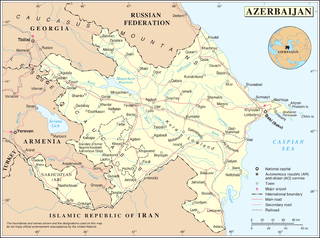
The Borders of Azerbaijan define the land and maritime borders of Azerbaijan. Azerbaijan has international land borders with 5 states.
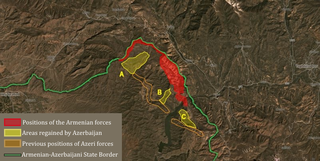
Gyunnyut Operation or Gyunnyut clashes began on 20 May 2018 between the Armenian Armed Forces and Azerbaijani Armed Forces. Clashes and subsequent military operations ended with Azerbaijan regaining several occupied villages and strategic positions within the Nakhchivan Autonomous Republic, these areas had previously been part of a no man's land between the Azerbajiani and Armenian lines. On the end of May, Nakhchivan Separate Combined-arms Army regained control of Gyunnut, a village in Sharur District that has been completely destroyed by the Armenian forces in 1992, and two strategic positions, Khunutdagh and Aghbulag. Azerbaijani Armed Forces also regained control of and took new positions on Kyzylkaya and Mehridagh strategic positions. They also reportedly took new positions in a previously unoccupied neutral zone in Nakhchivan near Armenian village of Areni in Vayots Dzor Province.


















